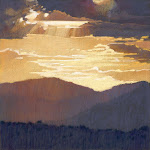One of the ways we, as pastelists or any artists producing works on paper, can make our artwork more desireable to collectors is to consider the issue of reflection. It is a hard reality of our passion that the pastel medium we love requires us to cover our paintings with a transparent substance in order to preserve and present them. Regular glass does our paintings no favor. If there is a light source you are often unable to see the art underneath. And I am surprised at the number of artists, collectors, and even galleries that think non-glare glass with it's milky, blurring characteristics shows our artwork at it's best.
The best way to frame our artwork is with a glass that reflects the least amount of glare but preserves the clarity of our images. That relegates us to spending extra money on AR (Anti-Reflective) glass or the gold standard, Museum glass. Thankfully, these surfaces also lend the added benefit of UV protection which will increase the lightfastness of our images.
Now the reason for this posting. Turns out AR and Museum glass, despite their ability to show our art at it's best, are very difficult to keep clean. Water spots it, and every fingerprint leaves it's mark. Then if you go near it with Windex and you are doomed. You will think you have ruined the glass - the streaks you create will not go away!
There is a very simple solution to keeping the glass clean. Remember this: Simply make a mixture of 1/2 plain water and 1/2 alcohol. Spray onto a clean cloth (microfiber is best) and wipe the glass until all the fingerprints. smears, and spots disappear. It's actually easy, and just costs pennies. Be sure and let your collectors know this is how to keep the glass clean - either include the instructions ina thank you note following the purchase, or write it out and tape to the back of the painting.
Sunday, May 9, 2010
Subscribe to:
Comments (Atom)



